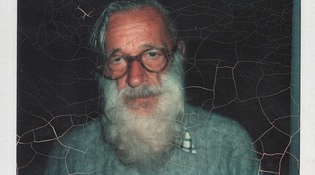 loading
loading
Arts & CultureObject lessonConned by the master Printer and photographer Richard Benson was dean of the Yale School of Art from 1996 to 2006. This essay is adapted fromThe Printed Picture, published by the Museum of Modern Art in conjunction with an exhibit there through June 1, 2009.  © Walker Evans Archive, The Metropolitan Museum of ArtThe photographer Walker Evans, in a 1974 Polaroid portrait shot by John Benson, the author's brother. View full imageThe Polaroid photography processes wound down in the 1980s with a small, beautifully designed camera called the SX-70. Sleek, made of stainless steel with a leather cover, these marvelous devices had reflex viewing and cranked out small square pictures that looked like no others. The cameras were made for the amateur market, and the film for them was designed with a space at the bottom of the print on which the photographer could write notes. This was a clever use of the area needed to hold the processing chemistry that was spread across the image area after exposure. Because the inventor of the Polaroid, Edwin H. Land, chose dyes that sharply cut portions out of the color spectrum, Polaroid color materials always had an interesting palette, with intense, saturated primaries. Many SX-70 prints suffered from a yellow cast that obscured these colors, but other Polaroid materials -- four by five and eight by ten inches -- showed them beautifully. SX-70 film came in packets of eight sheets, and it was almost irresistible to rapidly expose all eight before even seeing how the first one came out. It took a few minutes for the pictures to fully form, and I always suspected that there was a marketing ploy behind this, to keep the photographer clicking away, and hence spending money, in a way that wouldn't have happened if each exposure could be seen before the next was made. These pictures had a tough plastic cover sheet bonded to the image, and it turned out that you could make marks on them with a fingernail or by squeezing the print when it was still fresh. Many artist-photographers produced interesting work by such physical manipulation of SX-70 prints. Toward the end of his life Walker Evans, by then a photography professor at Yale, was given Polaroid SX-70 cameras and film to work with. I remember him carrying a couple of the cameras in his jacket pockets, with a case of the film in the trunk of whatever car he had managed to enlist to drive him around. Walker would find an interesting subject and rapidly expose a whole pack on it, thrilled with the prospect of seeing the pictures quickly and knowing that he had more than one copy of them. At one point he visited us in Rhode Island (he had conned me into doing the driving) and saw, hanging in our basement, a marvelous old rotten "Dead End" sign that my brother owned. Walker wanted the sign, and my cagey brother offered to trade it for a photograph. Walker said fine, pulled out an SX-70, made five pictures of the sign itself, and offered them to its owner. My poor brother realized he had been had but requested that one Polaroid be signed. Walker agreed, took the selected photograph, and wrote on the front, "for John Benson with grt. pleasure Walker Evans 6/29/86." He died the next year, on April 10, 1975.
The comment period has expired.
|
|